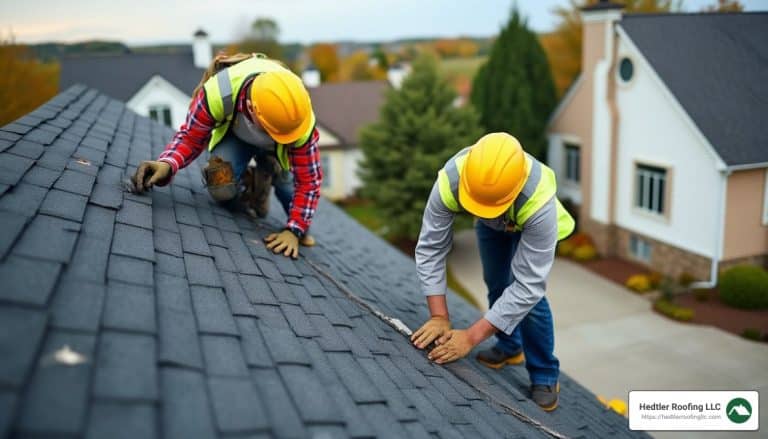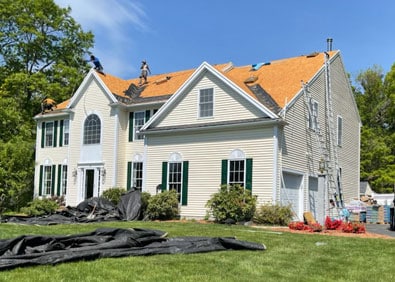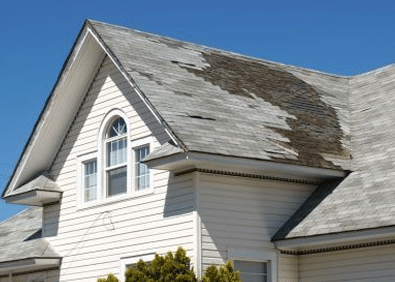
How often should a roof be replaced? This is a common question for many homeowners, especially those in Franklin or Bellingham, MA. Generally, most roofs need replacing every 20 to 25 years, but it varies based on material type:
A roof is one of your home’s most critical components, shielding your family and belongings from the elements. However, like anything exposed to the weather, roofs don’t last forever. Understanding when to replace your roof can help maintain your home’s durability and keep costly problems at bay. This guide will walk you through all you need to know, from signs it’s time for a replacement to what to expect during the process.
I’m Jason Hedtler, owner of Roof Experts, specializing in top-quality roofing solutions in Massachusetts. With my extensive experience, I’ve mastered understanding how often should a roof be replaced, ensuring your home receives the best care.
How often should a roof be replaced terminology:
– average cost to replace roof shingles
– average cost to tear off and replace roof
– complete roof replacement
Knowing when it’s time to replace your roof can save you from costly repairs down the road. Here are some key signs to watch out for:
Water stains on your ceiling or walls are clear indicators of a leaky roof. If you notice any signs of moisture, especially after heavy rain, it’s time to take action. Leaks can lead to mold growth and structural damage if not addressed promptly.
Shingles should lay flat against your roof. If you see curling, buckling, or cracked shingles, this indicates wear and tear. Damaged shingles can compromise your roof’s ability to protect your home.
Check your gutters and downspouts for shingle granules. When shingles shed granules, they lose their protective layer, increasing the risk of damage.
Moss, mold, and fungi are signs of trapped moisture. While a little moss might seem harmless, it can lead to bigger problems by holding moisture against the roof surface.
A sagging roof is a serious issue. It often indicates structural problems, such as a weakened roof deck or rafters. If you spot sagging, consult a professional immediately.
Valleys are crucial for directing water off your roof. If they rust, water can seep into your home, causing significant damage.
Missing shingles leave your roof vulnerable to leaks. If you notice any missing pieces, especially after a storm, it’s time to consider repairs or replacement.
Flashing around vents, skylights, and chimneys prevents leaks. If you find cracks or gaps, especially in older cement or tar flashing, it’s time to upgrade to metal flashing.
If you see daylight peeking through your roof boards from the attic, it’s a sure sign of damage. This means water can easily enter your home, leading to further issues.
Regular inspections and maintenance can help catch these signs early. If you’re noticing any of these red flags, it might be time to consult with a roofing expert. Up next, we’ll explore how often should a roof be replaced based on different materials and factors.
When it comes to roofs, how often should a roof be replaced varies based on several factors: the type of material, climate conditions, maintenance practices, and inspection frequency. Let’s break it down by roofing material.
Asphalt shingles are popular due to their affordability and ease of installation. However, they typically need replacement every 15-25 years. Key signs that your asphalt roof is nearing the end of its life include curling shingles, granule loss, and brittleness. Regular inspections, especially after severe weather, help catch these issues early. Homeowners in Massachusetts should be mindful of the climate’s impact, as heavy snow and wind can shorten the lifespan of asphalt shingles.
Metal roofs are known for their durability and can last 20-50 years. Proper installation is crucial to maximize their lifespan. While they withstand most weather conditions, hail damage and paint peeling are potential concerns. Routine maintenance and inspections can prevent minor issues from becoming major problems. Plus, metal roofs offer energy efficiency benefits by reflecting solar heat, which can be a plus in Massachusetts’ varied climate.
Wood shake roofs offer a natural aesthetic and last 30-40 years with proper care. They require regular maintenance to prevent damage from humidity, which can be a challenge in certain areas. Regular cleaning and treatment against pests and mold are essential to maintain the integrity of wood shakes. Keep an eye out for signs of rot or insect damage, and consider professional inspections to ensure the roof remains in good condition.
Slate roofs are the epitome of longevity, often lasting 100+ years. Their durability is best, but they do require regular repairs and professional maintenance to address any slate tiles that may crack or shift. The weight of slate also necessitates a strong roof structure. If you’re lucky enough to have a slate roof, proper care can ensure it protects your home for generations.
Flat roofs, common in commercial buildings, typically last 20-25 years. The quality of materials and installation play vital roles in their longevity. Regular inspections are crucial to catch any signs of pooling water or leaks, which are more common with flat surfaces. Ensuring proper drainage and addressing any issues promptly can help extend the life of a flat roof.
In Massachusetts, climate impacts every roof, making regular maintenance and inspections even more crucial. Insurance requirements may also dictate inspection frequency, so it’s wise to check your policy. Up next, we’ll explore the factors affecting roof longevity in more detail.
Understanding the factors that affect how long your roof lasts can help you make informed decisions about maintenance and replacement. Let’s dig into these key elements.
The climate in Massachusetts can be quite challenging for roofs. Humidity, heat, hurricanes, hailstorms, and wind speeds all play a role in wearing down roofing materials over time.
Regular maintenance is vital for prolonging the life of your roof. Here’s how you can keep your roof in top shape:
The longevity of your roof also hinges on the quality of its installation. Poor installation can lead to early failure, regardless of the material used. Ensure your roof is installed by experienced professionals who follow local building codes and standards.
Different roofing materials have varying lifespans:
Choosing the right material for your climate and maintenance capabilities is crucial.
Proper attic ventilation is often overlooked but is essential for roof longevity. It helps regulate temperature and moisture levels, preventing issues like ice dams and condensation that can damage the roof structure.
In summary, a combination of climate, maintenance, material, and installation quality determines how long a roof will last. By understanding these factors, Massachusetts homeowners can take steps to extend their roof’s life and protect their investment. Next, we’ll explore the best time to replace your roof based on these factors.
Timing your roof replacement can make a big difference. Here’s what Massachusetts homeowners need to know about the best time to tackle this important project.
Massachusetts weather is no joke. From icy winters to humid summers, your roof takes a beating year-round. But when is the optimal time to replace it?
Fall is often considered the best season for roof replacement. The weather is typically more consistent, with cooler temperatures and less chance of rain. This allows roofing materials to set properly without the stress of extreme heat or cold.
Spring inspections are also crucial. After the harsh winter months, spring is a great time to check for damage. Spotting issues early can help you plan a roof replacement before the busy summer season.
Consistency in weather is key when replacing a roof. You want to avoid times when there’s a high likelihood of rain or snow, which can lead to delays and complications in the installation process.
In Massachusetts, the weather in late spring to early fall is generally predictable, making it an ideal window for roof work. During this time, the mild temperatures help ensure that materials like asphalt shingles adhere and seal properly.
Because roofing projects are weather-dependent, it’s wise to plan ahead. Book your roofing contractor well in advance to secure your spot during these optimal months. Waiting until the last minute can leave you at the mercy of unpredictable weather and contractor availability.
By understanding these seasonal and weather considerations, you can choose the best time for your roof replacement, ensuring a smoother process and optimal results. Next, we’ll answer some frequently asked questions about roof replacement to help you further in your decision-making process.
Recognizing the signs that your roof needs replacing can save you from costly repairs. Water damage is a major indicator. Look for moisture marks on your ceilings or walls, which can signal leaks. Peeling paint or damp rafters in your attic are also red flags. These issues mean water is seeping into your home, potentially causing structural damage.
Leaks are another obvious sign. If you notice water dripping during rainstorms, it’s time to consider a new roof. Don’t wait until the situation worsens, as delayed action can lead to more extensive and expensive repairs.
The life expectancy of a roof varies based on the materials used. Generally, roofs last between 25 to 50 years, depending on factors like material quality and durability.
The key to a long-lasting roof is regular maintenance and inspections, which help catch potential problems early.
For shingle roofs, the general rule of thumb is replacement every 20 to 30 years. However, this can vary based on the type of shingles:
Regular inspections are crucial. They help identify issues like curling shingles or granule loss, which are signs that your roof is nearing the end of its life.
By understanding these key points, you can make informed decisions about your roofing needs. Up next, we’ll dive into the factors that affect roof longevity, so you can keep your roof in top shape for years to come.
At Roof Experts, we understand the importance of a reliable roof for homeowners in Massachusetts. With over 20 years of experience, we specialize in roof installations, replacements, and repairs, offering high-quality workmanship and exceptional customer service.
Why Choose Us?
Our Commitment
We are committed to providing our clients with peace of mind. Whether you need a minor repair or a complete roof replacement, our team is here to guide you through every step of the process. Our detailed inspections ensure that you receive a comprehensive assessment of your roof’s condition, allowing you to make informed decisions about your home’s protection.
For those considering a roof replacement, a well-maintained roof can improve the longevity and value of your home. Regular maintenance and timely replacements are key to avoiding costly repairs and ensuring your family’s safety.
To learn more about our services or to schedule a detailed inspection, visit our Roof Replacements page. Let us help you keep your home safe, secure, and beautiful for years to come.

Roof Installations

Roof Replacements

Roof Repairs